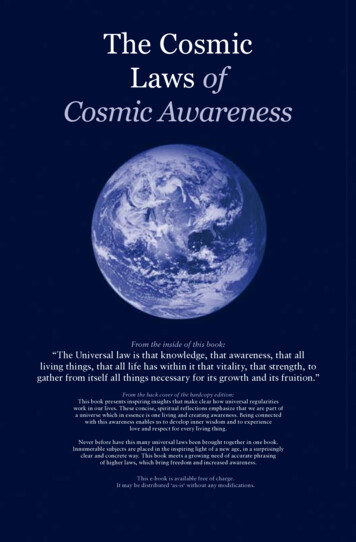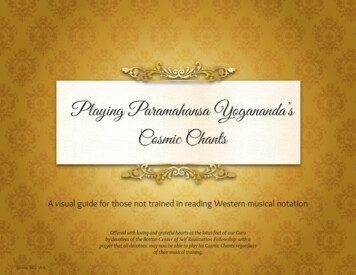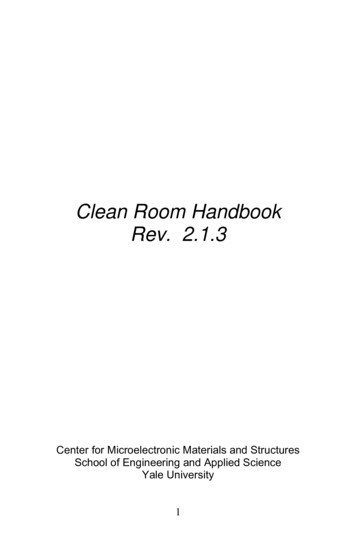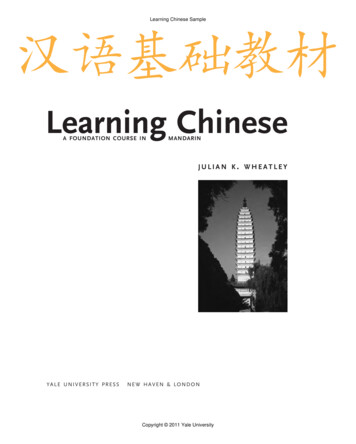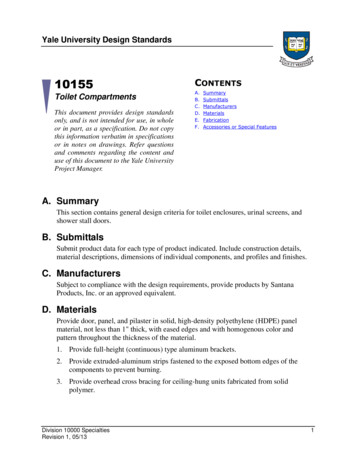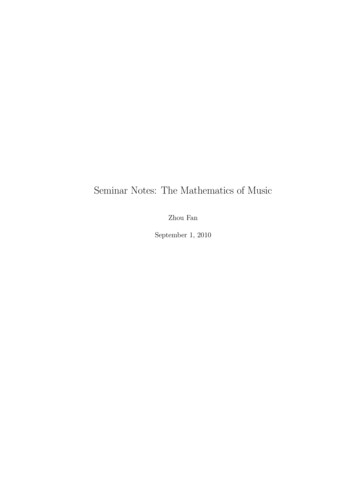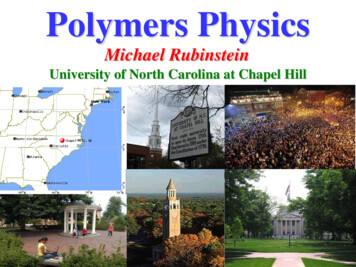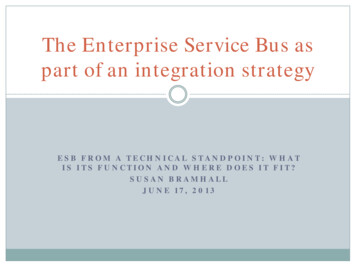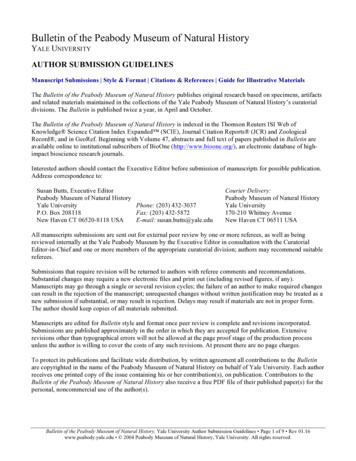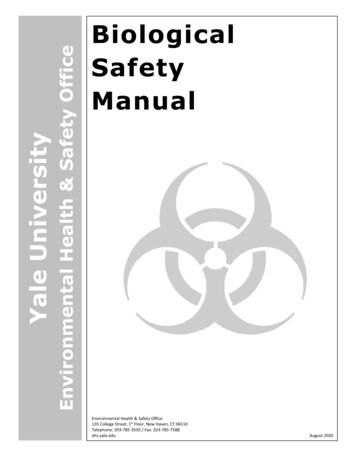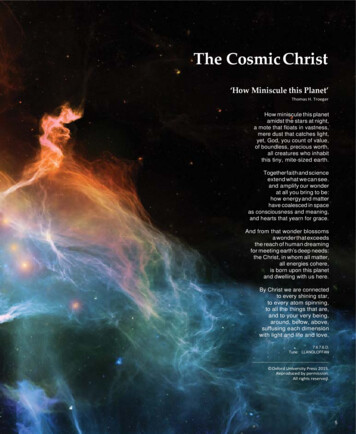
Transcription
The Cosmic Christ‘How Miniscule this Planet’Thomas H. TroegerHow miniscule this planetamidst the stars at night,a mote that floats in vastness,mere dust that catches light,yet, God, you count of value,of boundless, precious worth,all creatures who inhabitthis tiny, mite-sized earth.Together faith and scienceextend what we can see.and amplify our wonderat all you bring to be:how energy and matterhave coalesced in spaceas consciousness and meaning,and hearts that yearn for grace.And from that wonder blossomsa wonder that exceedsthe reach of human dreamingfor meeting earth’s deep needs:the Christ, in whom all matter,all energies cohere,is born upon this planetand dwelling with us here.By Christ we are connectedto every shining star,to every atom spinning,to all the things that are,and to your very being,around, below, above,suffusing each dimensionwith light and life and love.7.6.7.6.D.Tune: LLANGLOFFAN Oxford University Press 2015.Reproduced by permission.All rights reserved.5
Exploring the Cosmic ChristAn interview with the Rev. Catherine Amy KroppKarin HamiltonPhoto by Marc-Yves RegisThe Rev. Catherine Amy Kropp is a transitional deacon from the Episcopal Church in Maine, studying for her S.T.M. at Yale Divinity School, focusing on the cosmic Christ.He is the image of the invisible God, the firstborn of all creation; for in him all things in heaven and on earthwere created, things visible and invisible, whether thrones or dominions or rulers or powers—all things havebeen created through him and for him. He himself is before all things, and in him all things hold together.Colossians 1:15-17 (NRSV)he way many Episcopalians thinkabout Jesus is too small. Not thatthey’re wrong, but that Jesus is more:Jesus is the Christ. And if you think that’sjust a redundant phrase, you’re in for whatcould be a life-changing conversation.TThe Rev. Catherine Amy Kropp is a6transitional deacon from the EpiscopalChurch in Maine currently pursuing a Masterin Sacred Theology (S.T.M.) degree atYale on the cosmic Christ, with a focus onapplications for parish ministry.She is a former high school science teacherwho yearned to bring a more spiritualperspective to her students so that, forexample, they could see how recyclingplastic honored the sacredness of God’screation. Instead, she is now doing thereverse, bringing more science into theologythrough teaching and learning about thecosmic Christ.
It all started with one forum on thecosmos asking, “where was Christ inall this,” using images from the Hubbletelescope, drawing on her sciencehim a while to get used to thinking about the cosmic Christ. “Christnot only appeared at a certain point in time . but was present fromthe beginning and present across all time and space,” he said. “She[Catherine Amy] gets you to ask if there’s a divine love behind thewhole thing.”As an added benefit to their discussions, Sam noted that ittransformed the way he saw the outdoors, providing what he calleda broader “spiritual history” of constant change and transformation.IN WHOM ALL THINGS HOLD TOGETHERbackground, and inviting discussion.While earning her M.Div. at Yale Divinity School, Catherine Amyserved her seminarian internship at St. Peter’s in Cheshire, whichalready had a good understanding of the sacredness of God’screation and actively participated in related ministries. The rector, theRev. Sandra Stayner, welcomed the opportunity to have CatherineAmy join them.Sandy recalled noticing how Catherine Amy’s love of the outdoors(she is also a certified Maine Guide) and of science began tocoalesce with her divinity school studies and in particular with herdrive to explore the second person of the Trinity, realizing that allthings are with God from the beginning.“It began to be clear in her mind that the second person of theTrinity is more than the ‘human face of God’,” Sandy said, excitedabout watching the spiritual growth taking place. “There was acosmic element, and she began to pursue that.”It all started with one forum on the cosmos, recalled CatherineAmy, asking, “where was Christ in all this,” using images from theHubble telescope, drawing on her science background, and invitingdiscussion. It grew over time to regular Sunday adult forums plusongoing discussion groups.Many in the congregation were supportive and interested in therelated sermons as well as the forums and discussion groups thatshe led about the cosmic Christ. The questions pushed them all intodeeper contemplation and reflection.Sam Dunlop, a member of the parish who participated in the forumsand discussions, said he learned there was already a basis for it inChristianity, going back to its wisdom and prophetic traditions.“I liked that it gets at some of the mystical traditions but doesn’tcommand that one drop rational ideas,” he said. Still, he said, it tookCatherine Amy is particularly drawn to the writing of Paul to theColossians in Chapter 1, verses 15-20.“Christ is described as the one through whom all things are madeand in whom all things hold together, and that was my starting point. for my own personal journey,” she said in an interview late thispast August, noting that others may “fall into it” through differentplaces in Scripture, or their own mystical experience, or throughcontemplation. She described it as “like when you feel somethingclick,” like waking up, like remembering something that had beenforgotten, and admitted it was very difficult to find language todescribe it.“It made me really stop and think about what I understood Christ tobe, which was the human Jesus, the one who walked this earth andwhose story I knew; the good news I was hearing, the passion story,the mystery of life, death, and the resurrection. All that was sort ofbroken open into a bigger question for me: What does it mean thatChrist was before all things, before this human Jesus? I was puzzledand intrigued by the phrase, ‘all things’ because logically, and in ourmodern way of thinking and understanding of time — which is linear— it doesn’t really make sense.“It’s like seeing something beautiful or artistic or hearing beautifulmusic," she said, continuing to explain. "It stirs your heart and you fallinto something enticing. That was my starting point, and the one I goback to.”Next, she started to wonder why it mattered, which turned out to beprofound.“’All things’ is a lot of things!” she said. “You can’t just think aboutthe human story . you’re thinking about the rocks and the animalsand the creatures and their relationships and the whole cosmos andeverything,” she said.As she continued to explore it, Catherine Amy said she was gratefulto find “mentors” who had asked the same questions and studiedit more deeply. First among these for her was Pierre Teilhard deChardin. She continues to discover more and more thinkers on thesematters.7
IN THE NAME OF IT ALLIn the name of allthat is we come together.In the name of the stars and galaxies;in the name of the planets,moons and the sun;in the name of all that is we come.In the name of allthat is we come together.In the name of the oceans and the sea;in the name of the mountain,desert and plain;in the name of all that is we come.In the name of allthat is we come together.In the name of the buffalo and bear;in the name of the turtle,eagle and whale;in the name of all that is we come.In the name of allthat is we come together.In the name of the cactus and the fern;In the name of the flower,tree and herb;in the name of all that is we come.In the name of allthat is we come together.In the name of the elements of life;in the name of the soil,water and air;in the name of all that is we come.In the name of allthat is we come together.In the name of the children of earth;in the name of the spiritbreathing in all things;in the name of all that is we come.“In the Name of All That Is,” by Jan NovotkaCopyright 2003, by Jan Novotka’s Music LLC. Used with permission.(JanNovotka.com)8“Teilhard de Chardin was a geologist who studied evolution and understoodthe slow work of God through the rocks, and was a Jesuit priest andstruggled in a very pioneering way to bring together evolution and matter,science and the mystery of Christ,” she said.He also served in World War I as a chaplain, and “stretcher-bearer.” Shemarveled that some of his insight came during the war.“It’s actually where some of his cosmic vision came into place, through thesuffering and the turmoil and the chaos of the trenches,” she said. “Youwould think you’d come out of that broken and full of despair, crushedby what humans can do . and yet [he came out of it] with heightenedcompassion for those who suffer. Yet this vision of his, from the darkness,was so profound and enduring. He wasn’t just sitting quietly in a beautifulspot or stargazing.”As her understanding kept growing, she noticed that her language was failingto keep pace.“The words are frustrating to me, but I see it and feel that this is thepresence of God, calling to us now, in a way that invites us to see, literally,with our physical vision, the world is radiant through Christ all the time.And that it matters, it’s urgent. And then [the understanding] falls into howwe understand social justice and how we see ‘the other’ as precious, andhow we see the earth as part of ourselves, and ourselves as embeddedin the earth. It’s become practical, for me, rather than a vision that’s justtheological.”“BE STILL AND KNOW THAT I AM GOD”Conversations at St. Peter's were essential to ongoing reflections. Parishionersasked about why “cosmic Christ” and not “Great Mystery” or anythingreferencing the Trinity. They wanted to know whether focusing on thecosmic Christ was a deterrent to conversation with people from differentfaith traditions. They struggled with traditional linear ways of thinking, anddualisms common in our culture.“I guess it’s hard to explain this, but to me, Jesus and the cosmic Christ arenot separate,” said Catherine Amy. She and the parish group looked at theprologue to the Gospel of John, who wrote about the “Word made flesh,”and also to the wisdom traditions, finding what could be called an organizingprinciple to the universe that comes before Christianity.“And yet Christ came into this work in a very particular moment in themystery of God’s love, and became incarnate, and that love is infinite andtimeless,” she said. “It’s the mystery of the incarnation of matter and spirit;it’s the Jesus we know, who walked the earth and who we read aboutthrough the gospels, who is this cosmic phenomenon. There’s no difference,even though it feels like it doesn’t fit into our linear way of thinking.“We have so many dualisms: heaven and earth, male and female, matter andspirit, human and cosmos, human and God, young and old, mind and body,and we sort of think these are natural categories. But there is a discussionthat comes sometimes through contemplative circles, or mystical writings,of non-duality, where you fall into a realm of tension between two thingsthat you once thought were separate, but aren’t. That’s what the 'cosmicChrist' is doing for me. If you go into the mystery of the incarnation, it’s very,very hard to understand how the human Jesus could be the cosmic Christ
because [of the] way [we're] conditionedas a modern human being[s], educated in acertain way, through separated disciplines,and the way we use metrics for progressand how we think about results.”The parish group at St. Peter's learned moreabout Christianity's contemplative tradition,which she said teaches us to be quiet,empty our minds, and be still. It’s therewhere she said she finds “moments of nonduality” that may be glimpses into a realitybigger than one she thought she knew,where the concept of the cosmic Christmakes sense; where a “resurrected life” canbe experienced here and now.Catherine Amy realizes these moments maybe fleeting, yet their brevity doesn’t diminishtheir value.The words are frustrating tome, but I see it and feel thatthis is the presence of God,calling to us now, in a way thatinvites us to see, literally, withour physical vision, the worldis radiant through Christall the time.Catherine Amy Kropp“I don’t think we can always hold thisvision, as we’re always so distracted,” shesaid. “There are so many demands on ourtime and our energy, and many of themare very important – loved ones who needattention, for example – and we can’t just sitand contemplate. But I think that when wedo — and the scriptures are full of this youknow, telling us to 'arise,' 'taste and see,''awake,' for example — the world becomesradiant, and you’re part of it. We all haveour moments where our hearts are still, andwe have a moment of revelation. It’s a veryintimate moment with God.”YOU MATTERJust like the small moments are brief portalsto something more vast, our responses canbe in small actions, as well.“When we see, we know what to do, in ourown little space and time of this world, andit will be relevant to the particularity of yourlife,” said Catherine Amy, still struggling tofind the words to adequately convey thevision.For example, she said, you might suddenlyrealize that you can open up your heart tothe person right next to you, to be morecompassionate, or you might see yourneighbor who you didn’t notice before. Or,you might suddenly have the eyes to seethe suffering around you and you might bewilling to witness. Or, in a more mundaneor more practical sense, she said, you might9
realize it actually does matterif you throw away or recycleyour coffee cup, or you mightthink of the landfill when youwalk into the grocery store andsee everything so clean andsanitized and packaged, andthink of where all of it is going;you might actually buy thingsdifferently.“And you might actually thinkthat you matter,” she said.She’s concerned that oursociety focuses too muchon results, on progress orproducts, so that these “smallacts” may be too easilydismissed by people.The acknowledgment of the cosmosbecomes an integral part of the narrativeof God’s incarnation in Christ, allowingfor growth in human spirituality, thedeepening of the communion betweenhumanity and the universe, the recognitionof the preciousness of all forms of life, and,most importantly, a greater sensitivity toBut we all have that sacredinner space where God knowsour true name and our truereality and 'knit us togetherin the womb before we wereborn,' and that primal sense ofGod. And when we’re enteringinto it with God our creator —with whatever language we’reusing to grasp this mysteriousreality — we hear God’s voice,whatever it is that God needsto say to you. And you realizeyou’re beautiful and loved andthat everything you do matters,and you’re empowered.”NEXT STEPS:BACK TO SCHOOLComing out of her experienceat St. Peter’s, exploring the“Instead of saying to yourself,cosmic Christ in a parishCatherine Amy Kropp‘Well, I need to go save thesetting, having also led aworld today,’ or, ‘I need torelated retreat for anothersolve this big problem [in theparish in ECCT, Catherine Amyworld] today,’ maybe when you fall into a moment of vision, doingdecided to stay a bit longer in Connecticut. She’s back at Yale, takinganother year to earn her S.T.M. degree (Master of Sacred Theology)the littlest things are the most profound.” she said.in their Religion and Ecology interdisciplinary program, in additionShe connected that back to Jesus’ teaching that the last will be first,to the M.Div. she earned earlier, prior to her ordination to theand the first will be last. “Be kind, love your neighbor as yourself,transitional diaconate. Her advisor is Professor Mary Evelyn Tucker,think of those on the margins, and wake up to the little things nota widely-known lecturer and researcher on religion and ecologymiles away but right around you," she said.and author or editor, with her husband John Grim, of related books,video, courses, and an annual forum.“I'm struggling with the language,” she added, “but what I'm tryingto describe is basically the hinge or the journey from contemplationCatherine Amy’s S.T.M. proposal was titled, “For the Study of theCosmic Christ with a Focus on the Applications for Parish Ministry,”to action. There’s some sort of mysterious moment. It's veryintimate and personal to you with your journey with God, that whenand began with this:it happens you know how to act. I can't tell somebody how to act orlive their life. Maybe I can walk with them if they want. I can listen.There is an urgent need for the study and celebration of the cosmicsuffering and injustice.GOD'S GOOD EARTH ı PRAISE AND PRAYER FOR CREATIONThe hymn text and the litany (also a hymn text) featured on these pages were recommended by Anneand Jeffery Rowthorn and are included in their new book to be published this November, God's GoodEarth: Praise and Prayer for Creation, by Liturgical Press. Both widely known, respected, and published,the Rowthorns live in southeastern Connecticut and attend St. Ann's, Old Lyme. Jeffery, resigned bishopsuffragan of ECCT, has written hymns and litanies and compiled related books; Anne has compiled fourcollections of ecological writings. Order the book and read more at litpress.org.10
Christ in Christian ministry to address the social andecological concerns within the modern culture of the UnitedStates and globally. The understanding of the cosmic Christ,the one through whom “all things hold together” (Col 1:17),offers insight into the transcendence and beauty of humanexistence in the body of Christ. There is also a call to action.TO EXPLORE MORE ON THE COSMIC CHRIST,CONSIDER:Without embracing the cosmic dimensions of Christianity,Christians are missing essential parts of the Christiannarrative, including the immense beauty of God’s creationof which they are a part, as well as an awareness of theirresponsibilities to each other, all creatures and to theEarth. The acknowledgment of the cosmos becomes anintegral part of the narrative of God’s incarnation in Christ,allowing for growth in human spirituality, the deepening ofthe communion between humanity and the universe, therecognition of the preciousness of all forms of life, and, mostimportantly, a greater sensitivity to suffering and injustice. Trinity Retreat Center in West Cornwall held a weekend retreaton "God and the Cosmos" the weekend of the Perseid meteorshower.The result is an expanding sense of love and compassionfor humanity. There is greater force and capacity to fightinjustice and to help the marginalized, the weak, the poorand the persecuted; the ones through whom Christ leads usto discover the kingdom and beauty of God.The strength of this vision also lies in its ability to inspirethe preaching of the Gospel message during times thatare tumultuous, when people are divided, uprooted anddisconnected from each other and from the Earth. Itleads people to recognize and celebrate their cosmicconsciousness in the message that Christ is the one throughwhom God reconciles all things (Col 1:20; Phil 2:10).Catherine Amy plans to expand upon the work she beganat St. Peter’s in Cheshire to develop best practices inspiritual formation; an examen; a practical guide for groupexplorations of the natural world; training modules; possiblya sermon series; and other ways to share the awareness ofthe cosmic Christ.She concludes her S.T.M. study proposal with her hopeand prayer: “With this awareness and understanding of thecosmic dimensions of Christianity, Christians can participatein the work of earthly and spiritual renewal and developthe confidence and hope with which to address the globalecological crisis.”Karin Hamilton serves as Canon for Mission Communication &Media for the Episcopal Church in Connecticut. A Buddhist monk in Thailand has been “ordaining” trees for morethan two decades, wrapping them in orange clerical robes that areassociated with the sacred, as a way to end the rampantdeforestation taking place there. Programs and leaders from Kairos Earth and from Metanoia ofVermont. Yale University in New Haven offers a joint master’s degreeprogram in religion and ecology. It also offers a M.A.R. (Master ofArts in Religion) concentration in religion and ecology, holds anannual “Religion and Ecology Summit," and offers an online classopen to the public, “Journey of the Universe: A Story for OurTimes.” Mary Evelyn Tucker and John Grim are lecturers and researchersat Yale's School of Forestry and Environmental Studies as well asthe Divinity School, co-directors of the annual summit, coauthors and co-editors of related books, and producers of thefilm, Journey of the Universe, used in the online course. Related concepts you may encounter in your research: cosmicChrist; eco-spirituality; deep ecology; care for creation; Christianmysticism; Christian contemplative traditions; Celtic Christianity(and Celtic consciousness) More writers:Thomas Berry, C.P.The Rev. Cynthia BourgeaultJudy CannatoPierre Teilhard de Chardin, SJIlia Delio, OSFThe Rev. Matthew FoxJohn Philip NewellRichard Rohr, OFMBrian Thomas SwimmeNOTES: Richard Rohr, OFM, has a series of meditations, and also leadsconferences and programs, on the cosmic Christ. Next spring(2019) Richard Rohr, John Dominic Crossan, and Jacqui Lewisare hosting a conference, “The Universal Christ: Another namefor everything.” There are many other writers and other programs. If a groupfrom two or more Episcopal parishes in ECCT want to develop arelated ministry network, they may collect a more comprehensiveset of resources for recommended study, identify retreats andworkshops, etc.
the reach of human dreaming for meeting earth’sdeep needs: the Christ, in whom all matter, all energies cohere, is born upon this planet and dwelling with us here. By Christ we are connected to every shining star, to every atom spinning, to all the things that are, and to your v
